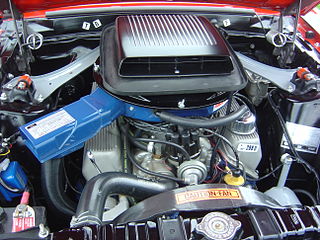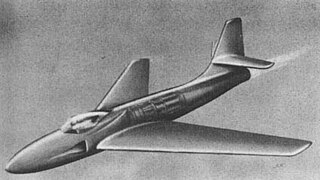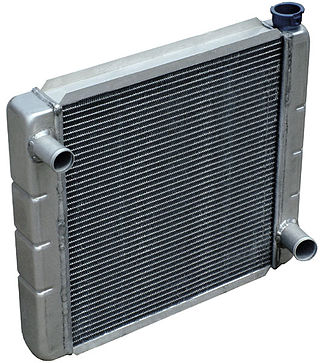
In engineering, the Miller cycle is a thermodynamic cycle used in a type of internal combustion engine. The Miller cycle was patented by Ralph Miller, an American engineer, U.S. Patent 2,817,322 dated Dec 24, 1957. The engine may be two- or four-stroke and may be run on diesel fuel, gases, or dual fuel. It uses a supercharger to offset the performance loss of the Atkinson cycle.
Air-augmented rockets use the supersonic exhaust of some kind of rocket engine to further compress air collected by ram effect during flight to use as additional working mass, leading to greater effective thrust for any given amount of fuel than either the rocket or a ramjet alone.

An intercooler is a heat exchanger used to cool a gas after compression. Often found in turbocharged engines, intercoolers are also used in air compressors, air conditioners, refrigeration and gas turbines.

The Roots-type blower is a positive displacement lobe pump which operates by pumping a fluid with a pair of meshing lobes resembling a set of stretched gears. Fluid is trapped in pockets surrounding the lobes and carried from the intake side to the exhaust. The most common application of the Roots-type blower has been the induction device on two-stroke diesel engines, such as those produced by Detroit Diesel and Electro-Motive Diesel. Roots-type blowers are also used to supercharge four-stroke Otto cycle engines, with the blower being driven from the engine's crankshaft via a toothed or V-belt, a roller chain or a gear train.
A centrifugal supercharger is a specialized type of supercharger that makes use of centrifugal force in order to increase the manifold air pressure, MAP. An increased MAP allows the engine to burn more fuel, which results in an increased power output. Centrifugal superchargers are generally attached to the front of the engine via a belt-drive or gear-drive from the engine's crankshaft.

A cold air intake (CAI) is usually an aftermarket assembly of parts used to bring relatively cool air into a car's internal-combustion engine.
Volumetric efficiency (VE) in internal combustion engine engineering is defined as the ratio of the equivalent volume of the fresh air drawn into the cylinder during the intake stroke to the volume of the cylinder itself. The term is also used in other engineering contexts, such as hydraulic pumps and electronic components.

A shaker scoop is an automobile term for an air intake for combustion air that is mounted directly on top of the engine's air cleaner and protrudes through a hole in the hood. Since it is fastened directly to the engine, it moves with the engine's movement and vibration on its mountings, thus the 'shaker' name.

Car tuning is the modification of a car to optimise it for a different set of performance requirements from those it was originally designed to meet. Most commonly this is higher engine performance and dynamic handling characteristics but cars may also be altered to provide better fuel economy, or smoother response. The goal when tuning is the improvement of a vehicle's overall performance in response to the user's needs. Often, tuning is done at the expense of emissions performance, component reliability and occupant comfort.

The Ford Mustang Mach 1 is a performance-oriented option package of the Ford Mustang muscle car, originally introduced in August 1968 for the 1969 model year. It was available until 1978, returned briefly in 2003, 2004, and most recently in 2021.

A ram-air intake is any intake design which uses the dynamic air pressure created by vehicle motion, or ram pressure, to increase the static air pressure inside of the intake manifold on an internal combustion engine, thus allowing a greater massflow through the engine and hence increasing engine power.

An intake is an opening, structure or system through which a fluid is admitted to a space or machine as a consequence of a pressure differential between the outside and the inside. The pressure difference may be generated on the inside by a mechanism, or on the outside by ram pressure or hydrostatic pressure. Flow rate through the intake depends on pressure difference, fluid properties, and intake geometry.

A NACA duct, also sometimes called a NACA scoop or NACA inlet, is a common form of low-drag air inlet design, originally developed by the U.S. National Advisory Committee for Aeronautics (NACA), the precursor to NASA, in 1945.
A glossary of terms relating to automotive design.

In an internal combustion engine, a supercharger compresses the intake gas, forcing more air into the engine in order to produce more power for a given displacement.
The following outline is provided as an overview of and topical guide to automobiles:

Radiators are heat exchangers used for cooling internal combustion engines, mainly in automobiles but also in piston-engined aircraft, railway locomotives, motorcycles, stationary generating plant or any similar use of such an engine.

The Meredith effect is a phenomenon whereby the aerodynamic drag produced by a cooling radiator may be offset by careful design of the cooling duct such that useful thrust is produced by the expansion of the hot air in the duct. The effect was discovered in the 1930s and became more important as the speeds of piston-engined aircraft increased over the next decade.

The Lamborghini Essenza SCV12 is a track-only sports car produced by the Italian automobile manufacturer Lamborghini under their Squadra Corse racing division. Introduced on 29 July 2020, it is the most powerful and the last purely naturally-aspirated car built by the brand.















